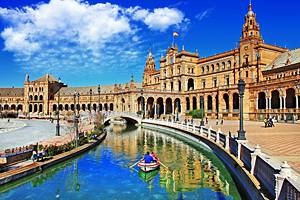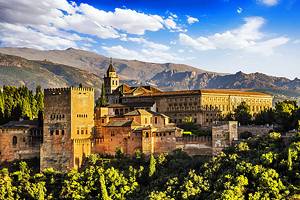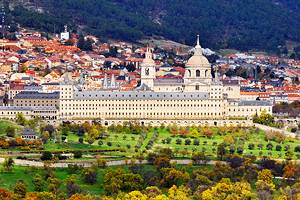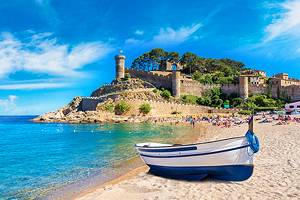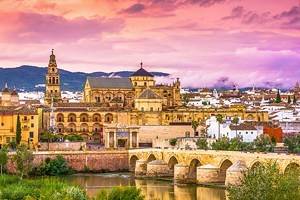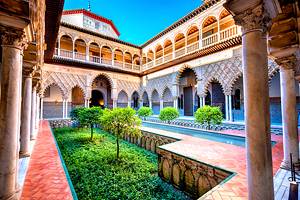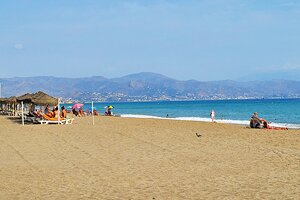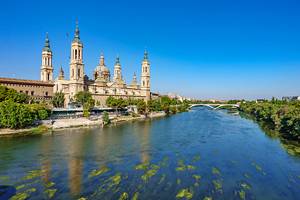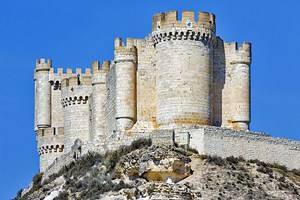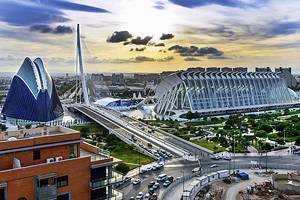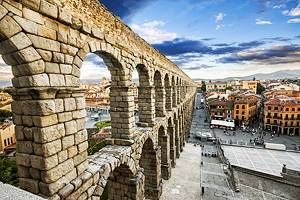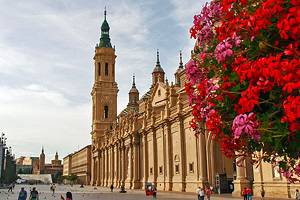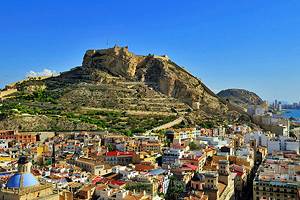Tourist Attractions in Cuenca
Cuenca is a magical sight, dramatically standing above a river gorge with its famous "hanging houses" clinging to steep, rocky slopes. This UNESCO World Heritage city is one of the most beautiful medieval towns in Spain. With its cobblestone lanes, town square, and old mansions, Cuenca has wonderfully preserved its old-world character.
Tourists enjoy wandering the ancient streets, discovering picturesque alleys and hidden corners. Fascinating historic monuments and fabulous views are found at every turn.
Cuenca also has outstanding art museums and festivals. For a rewarding cultural experience, visit during Easter to attend the Festival of Religious Music.
Discover the best places to visit in this enchanting city with our list of the top things to see and do in Cuenca.
See the Casas Colgadas (Hanging Houses)

Designated as a UNESCO World Heritage Site, the Hanging Houses are the most emblematic and famous spot in Cuenca. The picturesque Casas Colgadas of Cuenca are reached via the Calle Obispo Valero, built at the edge of a steep cliff overlooking the Huécar River. The houses cling precariously to the cliff side with their balconies projecting over the abyss.
The entire Huécar Gorge originally was lined with hanging houses, but only three of them remain. These remarkable medieval buildings were restored in the early 20th century. The house on the left hand side is known as the Casa de la Sirena (House of the Mermaid).
Address: Calle Obispo Valero
Visit Museo de Arte Abstracto Español

The Museum of Spanish Abstract Art is in one of the Casas Colgadas. Dramatically suspended above a sheer cliff wall, the building has three levels of gravity-defying balconies that jut out over the river gorge. The 15th-century house has been completely renovated but still reveals the original architectural elements, including wooden beam details on the interior.
The museum's exceptional collection focuses on Spanish Abstract paintings and sculptures of the 1950s and 1960s as well as works from the 1980s and 1990s. Visitors are astounded by the originality of the collection along with the variety.
This is one of the largest collections of modern art in Spain after the Museum of Contemporary Art and the Reina Sofia Museum in Madrid. The collection includes more than 700 art works by renowned Spanish abstract artists.
Among the artists represented are Eduardo Chillida, Manolo Millares, Gerardo Rueda, Antonio Saura, Eusebio Sempere, Pablo Serrano, Antoni Tàpies, Gustavo Torner, and Fernando Zóbel.
The museum is open every day of the week except Mondays. Tourists should keep in mind that most museums in Cuenca (including the Museum of Spanish Abstract Art) close from 2pm until 4pm (for lunch/siesta) and are only open for a half day on Sundays.
Address: Casas Colgadas, Cuenca
Catedral de Santa María la Mayor

Dating back to the 12th and 13th centuries, Cuenca's impressive cathedral stands proudly on the town's main square. Also known by the name of Nuestra Señora de Gracia (Our Lady of Grace), the cathedral features a mix of Norman and Gothic architectural details. Although the facade was damaged in 1902, the interior has been well preserved.
The richly decorated sanctuary and the 18th-century high altar by Ventura are especially noteworthy, as is the Renaissance arch, the Arco de Jamete. A unique triforium in the ambulatory is unlike any other church in Spain. Two artistic treasures are the 13th-century Mater Dolorosa by Pedro de Mena in the sacristy and a Crucifixion by Yáñez de la Almedina in the Capilla de los Caballeros.
Attached to the cathedral is the Palacio Episcopal (Bishop's Palace). The lower floors of the Bishop's Palace house the Diocesan Museum, which displays the cathedral's exceptional art collection, including the Christ on the Cross and Prayer in the Garden of Olives paintings by El Greco. Other treasures include the 13th-century Byzantine diptych from Mount Athos, exquisite goldsmith's work, elegantly crafted altarpieces, antique liturgical objects, and valuable tapestries.
Address: 1 Obispo Valero, Cuenca
See the Views from San Pablo Bridge

Among Cuenca's most important landmarks, San Pablo Bridge is one of the most popular, a footbridge originally built in the 16th century to connect San Pablo convent to the old town over the Huécar River. The current bridge was constructed in 1902 of iron and wood, and those who don't mind heights or a little swaying will enjoy the best possible views of the Hanging Houses.
Another famous Cuenca landmark is Torre de Mangana, also originally built during the 16th century and renovated many times since. It stands as a symbol of the city, known as the "tower of the hours" thanks to its prominent clock.
Location: Río Huécar, Cuenca
Convento de las Carmelitas Descalzas

This lovely Baroque convent provided a spiritual home for the Carmelite order of nuns in the 17th century. The convent is found at the highest point of Cuenca, with breathtaking views of the UNESCO-listed Huécar River Valley.
The old convent building now houses the Centro de Arte Contemporáneo, a large gallery of modern art that is a surprising juxtaposition in such a historic setting. The museum is part of the Fundación Antonio Pérez, which was founded by Antonio Pérez, an influential poet, editor, and artist.
The museum contains over 3,000 pieces of contemporary art, displayed in 30 different rooms. The collection includes paintings and sculpture, as well as other media. Abstract art and Pop art are well-represented, with pieces by Andy Warhol and Antonio Pérez.
Tourists can still visit the convent's historic church, which houses the marble and bronze tomb of Saint John of the Cross. The church also displays a noteworthy painting by José García Hidalgo.
Address: 20 Calle de Julián Romero, Cuenca
Museo Paleontológico de Castilla-La Mancha (MUPA)

The Paleontological Museum of Cuenca boasts an extensive collection of fossils (more than 34,000 items) that were excavated in the Castilla-La Mancha region. The collection of paleontological finds represents the period of 255 million to 550 million years ago.
The museum's dinosaur exhibits are among its most popular, especially with children. Visitors marvel over numerous models of dinosaurs both great and small, as well as information about the ecosystems in which dinosaurs lived.
The museum also features exhibits of long-extinct species like saber-toothed tigers and woolly rhinoceroses, as well as realistic scenes depicting Neanderthal hunters and cave dwellings.
Outside the museum, the Parque Paleontológico (Paleontological Park) is home to the largest of the dinosaur replicas. Visitors will have fun taking a stroll on the grass, among the sculptures of these monstrous ancient reptiles.
Address: 5 Calle del Río Gritos, Cuenca
Official site: https://mupaclm.es/
Museo de Cuenca (Museum of Archaeology)

The Museo de Cuenca is near the Casas Colgadas and is a worthwhile stop for tourists interested in archaeology of the Roman era. The collection displays antiquities that were discovered in the area surrounding Cuenca, which had an important ancient Roman settlement.
A highlight of the collection is the first-century marble bust of Lucius Caesar. Other interesting exhibits include the reconstruction of an ancient Roman kitchen and an assortment of antique Iberian dolls.
The majority of the museum's archaeological specimens were discovered at the ancient ruins in Segóbriga, where a first-century to second-century Roman settlement was uncovered. The excavation site includes the ancient city's theater, amphitheater, basilica, and thermal baths.
The museum is open every day of the week except Mondays. From Tuesday through Saturday, the hours are from 10am until 7pm with a long break for lunch/siesta between 2pm and 5pm. On Sundays, the museum is only open from 10am until 2pm.
Address: 12 Calle Obispo Valero, Cuenca
Túneles de Alfonso VIII
One of Cuenca's coolest "hidden" attractions is found underground. The Túneles de Alfonso VIII are a series of natural tunnels that were expanded over the centuries, to serve as pedestrian passageways beneath the town.
Portions of the tunnels are now open to the public via guided tours (Spanish-language only), during which tourists will learn about their uses as aqueducts and even crypts. The toured parts of the tunnel are well-lit and have wooden walkways that make it accessible to most travelers.
The tour guide explains the tunnels' construction and history, and discusses how the tunnels were used as shelters for townspeople during the Spanish Civil War. Tickets for the guided tours are available at the Cuenca Tourism Office on the Plaza Mayor.
Above the tunnels, the Calle Alfonso VIII is a lovely street lined with multi-story houses featuring brightly painted facades. Especially noteworthy buildings on this street are the 17th-century Casa de los Clemente Aróstegui and the palatial Casa del Corregidor.
Address: Tourism Office, 2 Calle Alfonso VIII, Cuenca
Museo de la Semana Santa de Cuenca

Each year, Semana Santa is celebrated in conjunction with Easter celebrations, and Cuenca's festivities are known far and wide. During this time, the city comes alive with its festival of religious music, which is marked by not only performances but also a massive parade featuring elaborate floats and costumed performers.
For those who aren't visiting at the end of March and early April, the Semana Santa Museum gives tourists a chance to experience it by way of an immersive audio-visual presentation that showcases highlights of the parade. The museum also houses exhibits of traditional costumes and notable items from the parade's long history.
During Cuenca's Religious Music Week, there are numerous concerts of sacred music performed by world-class orchestras, soloists, and choirs. These are performed at venues including the Catedral de Santa María la Mayor, the Convento de las Carmelitas Descalzas, and the Iglesia de San Miguel.
Address: 13 Calle Andrés de Cabrera, Cuenca
Spend a Night at the Parador de Cuenca

In a commanding position above the Huécar Gorge and opposite the Hanging Houses, the former Convent of San Pablo has been repurposed as a luxury hotel, part of Spain's national Parador association. The convent was built in the 16th century in Late Gothic style and has been renovated with exquisite attention to detail.
Designed to pamper visitors, the four-star Parador de Cuenca offers plush modern guest rooms and excellent amenities: gorgeous grounds with lush vegetation, an outdoor swimming pool, a charming café in what was the convent's chapel, and a gourmet restaurant in the historic refectory once used by monks.
At the restaurant, tourists can sample the region's traditional cuisine, which features specialties like ajoarriero (cod-potato spread); beans with partridge; Manchego cheese; truffled eggs; and alajú, a confection made with nuts and honey. Guests also enjoy the ambience, whether seated in the elegant dining room or on the pleasant terrace during summertime.
The Parador de Cuenca is located on the outskirts of Cuenca in a dramatic and serene setting. With its sheer walls at the edge of the cliff side, the building seems to sprout from the rocky promontory. The views are sublime, with the Casas Colgadas and the San Pablo Bridge in the distance.
Address: Subida a San Pablo, Cuenca
Historic Churches of Cuenca

Cuenca is home to many historic churches, which will interest tourists because of their religious significance, architecture, and cultural heritage.
Exemplifying Baroque Rococo style, the Oratorio de San Felipe de Neri (on the Calle Andrés de Cabrera) was designed by the architect José Martín de Aldehuela, built in 1739. The plain exterior belies a sumptuous interior with fanciful Rococo details, especially the side chapels and decorative columns with ornate capitals. Tourists can visit during hours of worship: Monday to Saturday at 6:30pm and Sundays/holidays at 11am and 1pm.
The Iglesia de la Virgen de la Luz (also known as San Antón) is dedicated to the Virgin Mary, the city's patron saint. This church (on the Calle San Lázaro) dates to the 16th century and was completed in the 18th century, with a splendid Rococo interior in contrast to the austere exterior. A precious object in the church is the Black Madonna, typically found in medieval pilgrimage churches. Tourists may visit Monday to Sunday from 8am to 1pm and 6pm to 8pm.
The scenic walk to the Santuario de Nuestra Señora de las Angustias (on the Bajada de las Angustias) gives visitors the impression of a pilgrimage because of the remote woodland setting. Arriving at this 17th-century shrine, tourists discover a Baroque church dedicated to the diocese's patron saint. It is a custom for visitors to kiss the cloak of the Viernes de Dolores (Friday of Pain) Madonna. The chapel is open to the public for visits every day year-round.
The beautiful San Julian Seminary was built in 1745 on the site of the Palace of the Marquis of Siruela. Tourists can admire the ornate Baroque façade but unfortunately cannot view the interior, as the monument is not open to the public.
Museo de las Ciencias de Castilla-La Mancha
A kids' favorite attraction is the Science Museum of Castilla-La Mancha. This fascinating museum takes visitors on a journey to uncover the mysteries of the universe. The museum features plenty of interactive exhibits that keep youngsters engaged.
The museum explores every facet of science, starting with the basics of physics, the "big bang," and earth sciences like geology, biodiversity, meteorology, weather, and climate. The museum also has a strong focus on climate change and energy, exploring clean energy sources.
Other exhibits move out of the atmosphere to the satellites that surround us, and beyond our planet to visit the moon, Mars, and more. Numerous audiovisual exhibits immerse the visitor in exploration of the solar system and even time itself.
Address: Plaza de la Merced, 16001 Cuenca
Day Trip to Monasterio de Uclés

About 70 kilometers from Cuenca, the town of Uclés was founded in the 10th century by the Order of Saint James. During this period, Uclés was the capital of their territory, although the Knights of Saint James later relocated to Malta.
The Monasterio de Uclés was built between the 16th and 18th centuries in the Renaissance style (although the southern facade is Baroque). Decorating the front doors are scallop shells on crosses of Saint James, the symbol of pilgrims who trekked the medieval "Way of Saint James" to Santiago de Compostela. With its double-cloistered courtyard, the building has a sense of serenity and harmony.
In the center of the courtyard is a Baroque wall adorned with the Order of Saint James' coat of arms. The monastery's 16th-century church features a magnificent paneled ceiling and medallion portraits of the Grand Masters of the Order.
The monastery is open to the public for cultural visits with timed passes. Advanced reservations are required.
Address: Calle Castillo 16450 Uclés
Explore La Ciudad Encantada ("Enchanted City" Rock Formations)

An incredible geological site is just 36 kilometers from Cuenca by way of the romantic and rugged Valley of Júcar. The scenic drive offers beautiful views of the town and the valley.
La Ciudad Encantada ("Enchanted City") is a stony labyrinth of crags, caves, lakes, and waterfalls, which, with a little imagination, can be seen to resemble a ruined city with its houses and streets and squares. The rock formations are the result of erosion hewn out of the sedimentary rocks, over the course of many thousands of years.
Plan an Excursion to Castillo de Belmonte

The Castillo de Belmonte is one of the most impressive fortresses of the Castile-La Mancha region. Standing on the San Cristobal hill, the 15th-century Gothic-Mudejar castle was constructed for Don Juan Pacheco, Marquis of Villena, for use as his private home.
The imposing medieval castle is shaped like a six-pointed star. Cylindrical towers add to the fairy-tale look.
The castle is open to the public for visits year-round. Tourists love the castle's medieval-themed events, such historical reenactments of 15th-century battles.
Address: 1 Calle de Eugenia Montijo, 16640 Belmonte
Official site: http://castillodebelmonte.com/en/
More Related Articles on PlanetWare.com
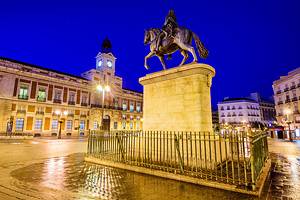
Exploring around Madrid: Tourists who enjoy Cuenca's historic churches and religious sites will appreciate many of central Spain's smaller cities that encircle Madrid, often visited as day trips from the large city. Among these is the historic city of Salamanca, home to two major cathedrals, as well as its university, revered for its impressive architecture and cultural significance.
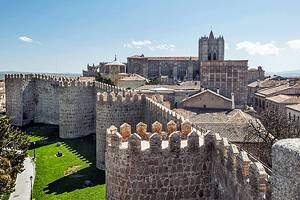
Historic Walled Towns: A place well-known for its cathedral and numerous medieval convents, Ávila is also revered for its well-preserved town walls (Murallas). The picture-perfect walled town of Segovia is also home to an impressive cathedral, as well as several historic churches, a monastery, and a small Jewish Quarter.
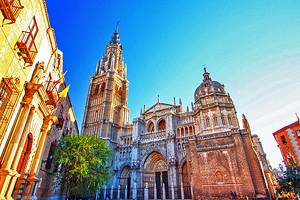
Holy Toledo: For those seeking a multicultural experience, Toledo is known for being home to not only important Christian monuments but also Islamic mosques and Jewish synagogues, and the city's variety of local traditional crafts reflects this centuries-old blend of influences.



